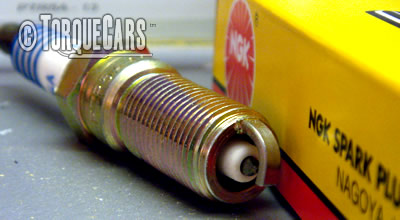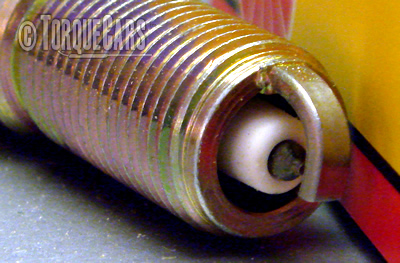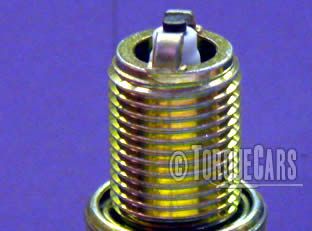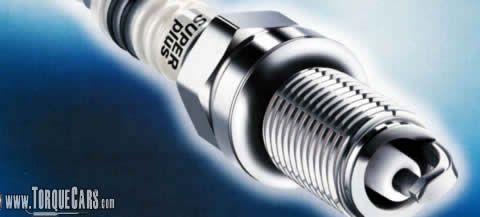The best spark plugs & HT leads improve performance.
"Lets spark up about engines"

An efficient engine needs a good supply of cold air laden with oxygen.
The correct mixture of fuel and a good spark to ignite the mixture.
The two main components of a plug are:-
1)The ceramic casing which is a good insulator and
2)The electrodes from the central tip and the negative pick up contact which is connected to the engine block.
The ceramic casing allows the spark to happen at the tip rather than it shorting out inside the spark plug core. We are talking about very high voltages as we are trying to get a spark to arc through a gap.
Be very careful working on any part of a cars high tension circuit and never work on it with the engine running. Many cold start faults are caused by faulty plugs or HT leads but lets first of all remind ourselves of what goes on inside our engine.
The suck has a big effect on the bang or combustion part of the process. Any restriction in the suck will affect the efficiency of the burn. The more air that gets sucked in the more fuel can be efficiently burnt.
Primarily you need a strong spark so make sure you have a good set of spark plugs with a slightly wider gap than standard (some TorqueCars members increase the gap by 20-50% !)

For older types of engine and plug lining the spark gap to be on the side of the intake can also increase the efficiency of the burn, this tends to happen automatically on modern plugs as they have a directional thread to facilitate this lining up.
To line up the electrode with the intake: With the plug out of the box make a mark on the ceramic edge, at the top so you can see it as it goes into the engine, with a marker pen to show which side the gap is on. This is called indexing the plug.
All plug threads will typically be different, especially on cheaper plugs. If the mark does not line up with the intake you'll need to use very thin washers to alter it's position. Ideally spend money on a good set of plugs that will all match up.
The spark will always take the shortest path so on a twin, triple or quad tipped plug the gaps must be the same all round otherwise you may just as well have a single contact point. Join the debate which is raging on in our forum to establish whether triple or quad plugs increase a cars performance or not.

High performance HT (high tension) Leads
Faulty high tension leads – (HT leads) will not cause a weaker spark they will just prevent the spark from happening so if you are having a misfire or uneven idle make sure the HT leads are in good order – flexing and bending them is often enough to damage then so make sure that they are handled carefully. A set of good quality HT leads will minimise electrical faults especially in extreme temperatures but will not in themselves increase performance.
The HT leads should have the lowest internal resistance and also provide electromagnetic shielding to prevent electrical interference with other car components such as the main engine control unit (including the radio). The lead should be matched to the voltage as the wrong size core can lead to heat problems and resistance issues. A sports lead size will be as large as 8.5 mm diameter with a 1 or 2mm internal core, whereas a street tuned car will probably get away with 7 or 8 mm sizes with a 1mm core size. Most HT lead suppliers can assist you in choosing the right length and core size for your cars application.
Modern cars no longer technically have HT leads, a low current is carried to the coil pack which generally sits on or near to the spark plug. The correct term for this is an ignition lead as it is not carrying a high tension voltage from the coil. Internal resistance and breaks and cracks will still have an effect on performance so the foregoing paragraph is still applicable.
Performance ignition coils and coil packs.
Just as a power transformer converts mains 240 volts into a usable 9 volts for your charger or appliance a coil will increase the voltage (in some installations up to 40,000 volts) allowing the creation of a spark which can jump the gap between the plugs. In some modern engines there is a separate coil pack with a separate coil for each spark plug. A faulty coil can also reduce the spark voltage to the point that no spark happens and you end up with a misfire.
Sports coils increase the power to the plug and allow a larger spark so match a sports coil with a larger plug gap. Timing the spark is critical too early (premature ignition) and the engine could be damaged and too late and the compression will be lower as the exhaust port opens potentially causing damage to the cat & exhaust as combustion move down along the exhaust.

Ideally you want to create a spark inside the cylinder of the engine and expose as much of the spark as possible to the compressed air and fuel mixture. Ideally the electrodes should be as thin as possible and be good conductors of electricity and the voltage should be as high as possible. Spark plug technology has really moved on in recent years and iridium tipped plugs allow an ultra fine electrode, last for up to 40,000 miles and are superb conductors of electricity.
Ignition system maintenance.
A good steady power supply is vital for a good strong spark, common problems in an old engine are actually caused by a bad earth connection (actually just the connection to the -ve battery terminal). Power regulators are available which ensure that a constant voltage is always available.
If you have a large ICE install and lots of other power draining accessories you may find that on a cold day when a battery typically struggles it will fail so ensure you have a battery with a large cranking power which although only gives 12V, it will do so in a much more steady manner and be more resilient to adverse conditions.
Ensure that the spark plugs are clean and in good condition as the terminals may well glaze and lose their conductivity to a small degree over time (expensive plugs are typically more resistant to glazing and can be left for longer periods of time).
So every six months or so it can be beneficial on normal plugs (we are not here referring to iridium or performance/long life spark plugs) to deglaze them by rubbing them over with a fine wire brush or fine metal file (do not use a fine grade of sandpaper - the bits will end up in the engine!). This keeps the conductivity of the contact points and ensures a strong spark thereby maintaining both performance and economy.
If you liked this page please share it with your friends, drop a link to it in your favourite forum or use the bookmarking options to save it to your social media profile.
Check out TorqueCars new YouTube channel, and see their awesome new content...
Feedback
Please use our forums if you wish to ask a tuning question, and please note we do not sell parts or services, we are just an online magazine.
Help us improve, leave a suggestion or tip
